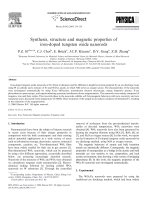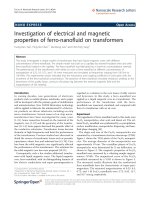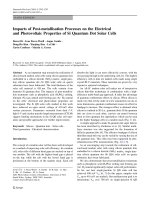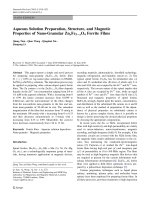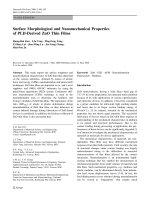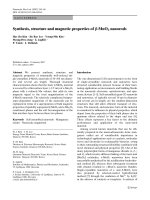Electrical and magnetic properties of mn doped si thin films
Bạn đang xem bản rút gọn của tài liệu. Xem và tải ngay bản đầy đủ của tài liệu tại đây (159.34 KB, 3 trang )
ARTICLE IN PRESS
Physica B 404 (2009) 1686–1688
Contents lists available at ScienceDirect
Physica B
journal homepage: www.elsevier.com/locate/physb
Electrical and magnetic properties of Mn-doped Si thin films
T.T. Lan Anh a, S.S. Yu a, Y.E. Ihm a,Ã, D.J. Kim a, H.J. Kim a, S.K. Hong a, C.S. Kim b
a
b
School of Materials Engineering, Chungnam National University, 220 Gungdong, Yuseong-gu, Daejeon 305-764, Republic of Korea
Korea Research Institute of Standards and Science, Daejeon 305-600, Republic of Korea
a r t i c l e in f o
a b s t r a c t
Article history:
Received 30 September 2008
Received in revised form
29 January 2009
Accepted 2 February 2009
We have studied electrical and magnetic properties of x at% Mn-doped Si thin films with high Mn
concentrations (x at% ¼ 7.5, 9.1, and 11.3), which were prepared by molecular beam epitaxy. Our data
reveals that the films are p-type semiconductors at room temperature, and their hole density is about
1020 cmÀ3. When temperature increases from 5 to 300 K, the resistivity of 7.5 at% Mn film decreases and
can be described by Mott’s variable-range-hopping model. The resistivity of 9.1 at% Mn film does not
change remarkably. In contrast, the resistivity of 11.3 at% Mn film increases, indicating metallic
characteristics at temperatures below 240 K. Magnetic measurements reveal that the films exhibit the
low-temperature ferromagnetic ordering, which is largely related to the presence of secondary phase.
& 2009 Elsevier B.V. All rights reserved.
PACS:
75.50.Pp
75.50.Lk
75.70.Ài
Keywords:
Si–Mn spintronic materials
Electrical and magnetic properties
1. Introduction
In recent years, diluted magnetic semiconductors (DMSs)
doped with the transitional metals, such as Mn-doped semiconductors III–V [1–3], II–VI [4,5], and group IV [6,7], have been of
much interest, because of applicability in spintronics devices.
Given the important role of Si in electronic devices, the inclusion
of Si in DMSs would represent a promising approach. Accordingly,
many attempts have been made to fabricate Mn-doped Si
ferromagnetic semiconductors. The first study on Si-based DMSs
has been carried out by Nakayama et al. [8]. It has been believed
that Mn in the Si host locates in both interstitial and substitutional sites, in which the interstitial site is preferred. This caused
an anomalous Hall effect at around 70 K, possibly due to the
presence of an internal magnetic field generated from Mn spins in
the Si matrix. Following this study, some works on dependences of
electrical and magnetic properties on the substrate temperature
and heat treatment for polycrystalline Si1ÀxMnx films were also
performed [9,10]. More recently, the ferromagnetic ordering above
400 K in Si1ÀxMnx has been reported [11,12]. It has been believed
that the nature of ferromagnetism in these thin films is related to
hole-mediated magnetic interactions. However, by studying
ferromagnetic Si0.95Mn0.05 bulks with Curie temperature (TC)
E75 K, Kwon et al. [13] have shown that the origin of
ferromagnetism is due to the interactions taking place between
à Corresponding author. Tel.: +82 42 821 6635; fax: +82 42 822 3206.
E-mail address: (Y.E. Ihm).
0921-4526/$ - see front matter & 2009 Elsevier B.V. All rights reserved.
doi:10.1016/j.physb.2009.02.001
the Mn ions in the Si host lattice. Thus, the nature of
ferromagnetism in this material family is still an issue of debate.
In this work, we have studied electrical and magnetic
behaviors of Mn-doped Si thin films (with high Mn concentrations) grown by molecular beam epitaxy (MBE). The combination
of the structural analysis by a means of X-ray diffraction allows us
to understand the magnetic nature of the samples.
2. Experiment
Thin films of x at% Mn-doped Si were grown on Si(0 0 1)
substrates in MBE chamber equipped with solid sources of Si and
Mn. Firstly, a native Si oxidation layer on the substrates was
removed by heating them up to 1100 1C for 30 min. After that, the
system was cooled slowly down to 200 1C at a maximum rate of
1 1C/s. This temperature was maintained for 60 min to deposit the
films. To make the films with different Mn concentrations, the Mn
flux was controlled by changing Mn-effusion-cell temperature.
Finally, the fabricated films were measured the thickness by an
Alpha-Step (500 Profiler). The Mn concentrations were measured
by X-ray photoelectron spectroscopy (XPS), using a VG HB-100
multilab with a monochromatic Al Ka X-ray source (hn ¼ 1486.6
eV). The structure of the films was characterized by an X-ray
diffractometer (XRD). Electrical properties and Hall effect were
determined by means of a quantum design physical properties
measurement system (PPMS-6000), where four probes were
arranged according to the van-der Pauw configuration. Magnetic
ARTICLE IN PRESS
1687
T.T. Lan Anh et al. / Physica B 404 (2009) 1686–1688
3. Results and discussion
Si (004)
The thickness of three samples of Si:Mn thin films with
different Mn concentrations were measured using an Alpha-Step.
After deposited for 60 min, the films have a thickness of about
100 nm (i.e., the growth rate is $16 A˚/min). By a means of XPS, we
obtained the Mn concentration in the samples to be 7.5, 9.1, and
11.3 at% and designated as the samples A, B, and C, respectively.
Fig. 1 shows XRD patterns of all the samples. The samples A and B
may be regarded as single phase as they exhibited XRD peaks
(0 0 2) at 33.07o and (0 0 4) at 69.21o generated from the Si
structure. Moreover, in comparison with the standard spectra
of silicon, Si(0 0 2) at 33.20o and Si(0 0 4) at 69.70o [JCPDS file
No. 80-0018], the positions of different peaks for the Mn-doped Si
thin films in this work shift toward the lower angle, indicating
the lattice expansion resulted from the incorporation of Mn in
Si lattice.
However, the Mn concentration increase in the sample C led to
the appearance of a new XRD peak (besides the peaks from Si)
centered at about 44o, which was identified to be an index (2 1 0)
of SiMn compound. At room temperature, we measured the hole
density of the films using on a Hall device. Our results showed
that the samples A, B, and C were p-type semiconductors, and
their hole densities were 1.3 Â 1020, 3.4 Â 1020, and 5.87 Â 1020
cmÀ3, respectively. We found that the Mn-concentration increase
in Mn-doped Si film resulted in the hole-density increase.
Similarly, Park et al. [6] also found the hole-density increases
progressively with enhancement in Mn concentration, in
Mn-doped Ge materials. Our data also demonstrated that the
resistivity of the films decreases with increasing Mn concentrations, consistent with earlier reports [7,10].
To further understand the dynamics of carriers in the films, we
investigated the temperature dependence of resistivity, r(T), in
the range of 5–300 K. As shown in Fig. 2 the resistivity
characteristics of the samples were significantly different. With
increasing Mn concentrations in Mn-doped Si films, resistivity of
the films decreased, in good agreement with our hole density
data. At temperatures T4$200 K, as temperature increased, r(T)
of the films decreased gradually, exhibiting conventional semiconductor characteristics. However, the variation of r(T) becomes
more complicated when temperature was below 200 K. For the
first film (sample A), r(T) increases which can be described by
Mott’s variable range hopping model of r(T) ¼ r0 exp(T0/T)1/4,
where T0 is a characteristic temperature and r0 is a constant [14].
We used this model to fit two temperatures of 5–25 K and
25–250 K, (Fig. 1(a) inset). For the first region, we obtained
T0 ¼ 1.6 K and r0 ¼ 2.12 O cm, while in the second region T0 and r0
were 10.3 K and 2.15 O cm, respectively. One can see that obtained
r0 values in two regions are close to each other while their T0
values are quite different. This could be due to the difference in
carriers’ hopping mechanism in two regions.
For the sample B, its resistivity at 200 K is 2.7 Â 10À4 O cm, and
with the temperature decreases r(T) changes just about 1.0%. This
feature is very different compared to that of the sample A (and C
as well). Clearly, the Mn doping into the Si host at an appropriate
value ($9.1 at%) makes resistivity of the film quite stable versus
temperature in the region To200 K. The situation becomes more
complicated as paying attention to r(T) of the sample C, where the
Mn concentration is 11.3 at%. With decreasing temperature from
240 K, r(T) decreases. This reveals that the film C exhibits metallic
behavior. Based on the feature of r(T) variation, we could divide
the r(T) curve into two parts. The first one (30 KoTo240 K)
corresponds to the r(T) value which decreases gradually, and the
other (To30 K) corresponds to the r(T) value which decreases
rapidly as lowering temperature (Fig. 2(b)). At temperatures
Mn-doped Si films
0.50
Sample A
Sample B
Sample C
0.45
Sample A
SiMn (210)
Sample B
-7.6
~25 K
-7.8
-8.2
0.35
0.3
0.30
0.25
TC
Sample C
0.21
40
50
60
70
80
Sample C
0.19
5 10 15 20 25 30
T (K)
0
30
0.4 0.5 0.6
T-1/4 (K-1/4)
0.20
0.20
20
Experiment
5 - 25 K
25 - 250 K
-8.0
ρ (mΩ.cm)
Resistivity (mΩ.cm)
Si (002)
0.40
Ln (ρ) (mΩ.cm)
measurements were carried out at temperatures between 5 and
300 K using a superconducting quantum interference device
(SQUID) magnetometer, in which the external magnetic field
was applied parallel to the film plane.
40
80
120
160
200
240
280
T (K)
2θ (Degree)
Fig. 1. XRD patterns of the samples A, B, and C corresponding to the Mn
concentration of 7.5, 9.1, and 11.3 at%, respectively.
Fig. 2. Temperature dependences of electrical resistivity, r(T) for the samples
(a) A, (b) B, and C; the insets show the r(T) data fitted to resistivity models as
described in the text.
ARTICLE IN PRESS
1688
T.T. Lan Anh et al. / Physica B 404 (2009) 1686–1688
H = 795.8 kA/m
Sample A
Sample C
M (kA/m)
50
M (kA/m)
40
30
40
T=5K
20
0
-20
-40
-4
20
-2
0
H (kOe)
2
4
properties but also in their resistivity characteristics. For the film
C, with lowering temperature a strong decrease in r(T) starts
taking place at TC, as can be seen in Fig. 2(b). At temperatures
below 30 K, the film exhibits ferromagnetic metal characteristics,
which could be fitted well to a power law T2.1 as mentioned above.
For the film A, the amount of secondary phase is probably low, and
thus a uniform phase of Mn-doped Si could be responsible for its
electrical and magnetic behaviors. However, an open question of
where the secondary phase existing in this film is still an issue for
our consideration.
4. Conclusions
10
0
0
50
100
150
T (K)
200
250
300
Fig. 3. The temperature dependences of magnetization for the samples A and C
under an applied field of 795.8 kA/m; the inset shows the hysteresis loops of these
two samples measured at 5 K.
below 30 K, we found that r(T) could be fitted well by a power law
Ta with a ¼ 2.1 (Fig. 2(b) inset). The a value is close to 2.0, which is
commonly observed in ferromagnetic metals [15]. As seen later,
this film has the ferromagnetic ordering at temperatures below
30 K. In the range 30 KoTo240 K, the temperature increase from
30 K leads to the increase in resistivity, suggesting that the film C
still exhibits metal behavior. Notably, r(T) of the film C is always
smaller than that of A and B (Fig. 2).
Fig. 3 shows the temperature dependences of magnetization for the films A and C under an external magnetic field of
795.8 kA/m, in which the field applied is parallel to the thin film
plane. One can see that with decreasing temperature from 300 K,
magnetization of the films increases, particularly at temperatures
below 200 K. We measured hysteresis loops of these films at 5 K
(see the inset of Fig. 3) and the values of saturation magnetization
(MS) of A and C are 53 and 42 kA/m, respectively, while their
coercive force (HC) is about 19.9 kA/m. These results reflect that
the films exhibit the ferromagnetic ordering at low temperatures.
Based on the M–T data, the TC, which are estimated from a
Curie–Weiss fit to the data as the magnetization approaches zero,
of the films A and C obtained are about 50 and 30 K, respectively.
Clearly, the increase in Mn-doping concentration in MnxSi1Àx films
results in reduction of MS and TC values. This is probably related to
the limitation of Mn solubility in the Si semiconductor matrix. At
high Mn concentrations, the short-range antiferromagnetic interaction between Mn ions could occur, resulting in the competition
for a long-range ferromagnetic interaction. This situation leads to
the reduction of magnetization and TC [3,16]. It is also suggested
that at high Mn concentrations Mn–Si related secondary phases
could be formed, which dominate magnetic feature of the thin
films. For Si–Mn binary systems, the TC value of SiMn is about 30 K
[17] while that of Si7Mn4 is about 45 K [18]. Among them, TC of
SiMn is close to that of the film C (with TCE31 K). This evidences
SiMn existed in our sample C, in good agreement with XRD data
shown in Fig. 1. Accordingly, the increasing Mn concentration in
MnxSi1Àx films results in not only changes in their magnetic
The electrical and magnetic properties of the thin films A, B,
and C have been investigated. At room temperature, all the films
are p-type semiconductors with the hole density is of about
1020 cmÀ3. As increasing temperature, the characteristics of
resistivity of the film depend strongly on Mn concentrations. For
the film A, resistivity decreases gradually that could be described
by Mott’s variable-range-hopping model. In contrast, resistivity of
the film C increases, revealing metallic characteristics at temperatures below 240 K. Particularly, for the film B, its resistivity is
quite stable at temperatures below 200 K. Magnetic measurements reveal that the films have the ferromagnetic feature at low
temperatures.
Acknowledgments
This work was supported by the Brain Korea 21 Program
(BK21, the Ministry of Education & Human Resource Development,
Korea).
References
[1] H. Munekata, H. Ohno, S. von Molnar, A. Segmuller, L.L. Chang, L. Esaki, Phys.
Rev. Lett. 63 (1989) 1849.
[2] H. Ohno, J. Magn. Magn. Mater. 200 (1999) 110.
[3] T. Dietl, H. Ohno, F. Matsukura, Phys. Rev. B 63 (2001) 195205.
[4] J.K. Furdyna, J. Appl. Phys. 64 (1988) R29.
[5] W. Prellier, A. Fouchet, B. Mercey, J. Phys. Condens. Matter 15 (2003) R1583.
[6] Y.D. Park, A.T. Hanbicki, S.C. Erwin, C.S. Hellberg, J.M. Sullivan, J.E. Mattson,
T.F. Ambrose, A. Wilson, G. Spanos, B.T. Jonker, Science 295 (2002) 651.
[7] S.S. Yu, T.T. Lan Anh, Y.E. Ihm, D.J. Kim, H.J. Kim, S.J. Oh, C.S. Kim, H. Ryu, Solid
State Commun. 134 (2005) 641.
[8] H. Nakayama, H. Ohta, E. Kulatov, Physica B 302–303 (2001) 419.
[9] H.K. Kim, D. Kwon, J.H. Kim, Y.E. Ihm, D.J. Kim, H.J. Kim, J.S. Baek, C.S. Kim,
W.K. Choo, J. Magn. Magn. Mater. 282 (2004) 244.
[10] D. Kwon, H.K. Kim, J.H. Kim, Y.E. Ihm, D.J. Kim, H.J. Kim, J.S. Baek, C.S. Kim,
W.K. Choo, J. Magn. Magn. Mater. 282 (2004) 240.
[11] F.M. Zhang, X.C. Liu, J. Gao, X.S. Wu, Y.W. Du, Appl. Phys. Lett. 85 (2004) 786.
[12] M. Boldue, C. Awo-Affouda, A. Stollenwerk, M.B. Huang, F.G. Ramos,
G. Agnello, V.P. LaBella, Phys. Rev. B 71 (2005) 033302.
[13] Y.H. Kwon, T.W. Kang, H.Y. Cho, T.W. Kim, Solid State Commun. 136 (2005)
257.
[14] K.M. Itoh, E.E. Haller, J.W. Beeman, W.L. Hansen, J. Emes, L.A. Reichertz,
E. Kreysa, T. Shutt, A. Cummings, W. Stockwell, B. Sadoulet, J. Muto1,
J.W. Farmer, V.I. Ozhogin, Phys. Rev. Lett. 77 (1996) 4058.
[15] R.R. Birss, S.K. Dey, Proc. R. Soc. (London), Ser. A, Math. Phys. Sci. 263 (1961)
473.
[16] J. Kudrnovsky, I. Turek, V. Drchal, F. Ma0 ca, P. Weinberger, P. Bruno, Phys. Rev. B
69 (2004) 115208.
[17] J.H. Wernick, G.K. Wertheim, R.C. Sherwood, Mater. Res. Bull. 7 (1972) 1431.
[18] U. Gottlieb, A. Sulpice, B. Lambert-Andron, O. Laborde, J. Alloys Compd. 361
(2003) 13.

